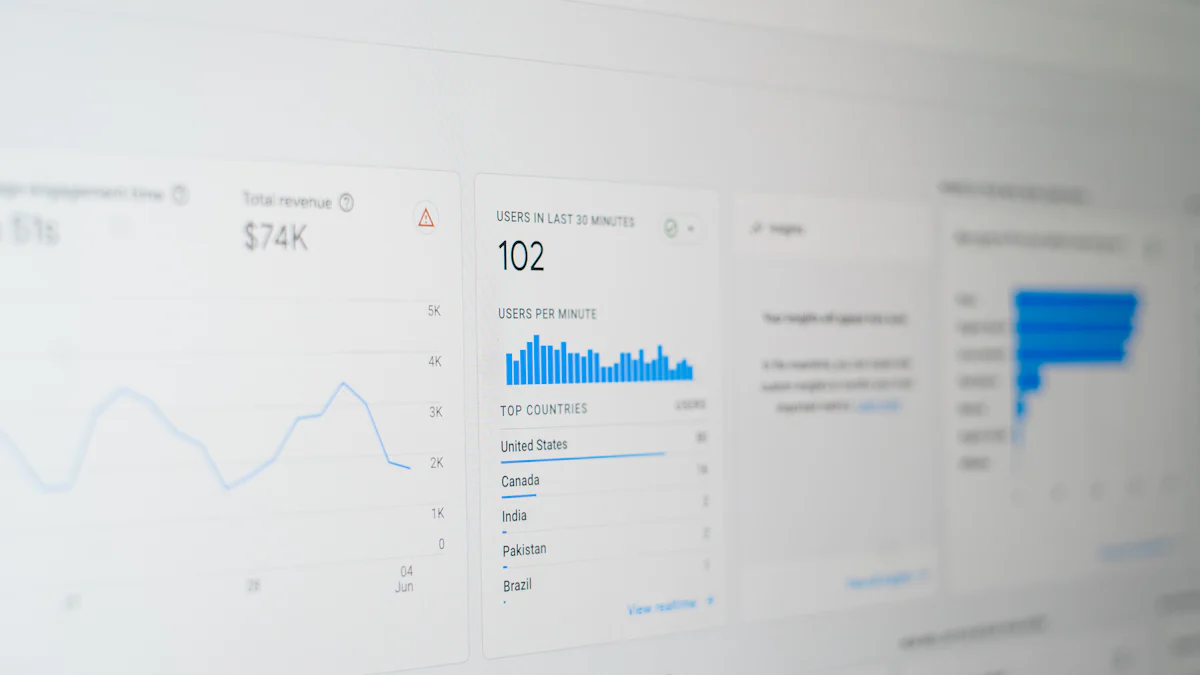What Drives Cost Reduction in Modern Data Infrastructure

Cost reduction is a pivotal aspect of contemporary data infrastructure. As organizations grapple with escalating storage costs driven by vast data volumes, data compression becomes indispensable for managing these expenses and optimizing capacity. Efficient data management not only boosts productivity but also enhances the quality of analytics. Businesses gain from improved data retrieval and optimized storage space, while deduplication further reduces costs by maximizing storage utilization. Modern trends highlight the importance of data efficiency, focusing on reducing file sizes and optimizing storage systems. These strategies empower organizations to realize substantial cost savings while maintaining a robust data infrastructure.
Key Drivers of Cost Reduction in Data Infrastructure

Cloud Adoption
Cloud adoption plays a crucial role in reducing costs within data infrastructure. Organizations benefit from cloud solutions through enhanced scalability and flexibility.
Scalability and Flexibility
Cloud platforms offer unparalleled scalability. Businesses can adjust resources based on demand. This adaptability ensures optimal use of resources, minimizing waste. Traditional infrastructure often lacks this dynamic capability, leading to inefficiencies.
Pay-as-you-go Models
The pay-as-you-go model provides financial flexibility. Companies pay only for what they use. This approach eliminates the need for large upfront investments. Traditional setups often require significant capital expenditure. Cloud models reduce financial risk by aligning costs with actual usage.
Managed Data Platforms
Managed data platforms contribute significantly to cost reduction. These platforms streamline operations and enhance efficiency.
Automation and Streamlining
Automation reduces manual intervention. Managed platforms automate routine tasks. This leads to faster processing and fewer errors. Streamlined processes improve productivity and lower operational costs.
Reduced Human Error
Automation also minimizes human error. Errors can lead to costly data mishaps. Managed platforms ensure accuracy and reliability. This precision enhances data integrity and reduces corrective expenses.
Overcoming Challenges in Data Infrastructure
Modern data infrastructure faces several challenges that can impact cost reduction. Addressing these challenges requires strategic approaches to ensure efficiency and flexibility.
Avoiding Cloud Lock-in
Cloud lock-in presents a significant challenge for organizations. Companies often struggle with dependency on a single vendor, which limits flexibility and increases costs.
Multi-cloud Strategies
Multi-cloud strategies offer a solution to cloud lock-in. Organizations can distribute workloads across multiple cloud providers. This approach enhances bargaining power and reduces reliance on one vendor. A diverse cloud environment ensures better resource allocation and cost management.
Vendor Independence
Vendor independence is crucial for maintaining control over data infrastructure. Companies should prioritize open standards and interoperability. This focus allows seamless transitions between different platforms. Organizations gain the ability to choose the best services without constraints, leading to optimized costs.
Managing Data Complexity
Data complexity can hinder efficient operations within data infrastructure. Simplifying data processes is essential for cost reduction.
Data Integration Solutions
Data integration solutions streamline complex data environments. These solutions consolidate disparate data sources into a unified system. A cohesive data structure improves data accessibility and analysis. Organizations benefit from reduced operational costs and enhanced decision-making capabilities.
Simplified Data Management
Simplified data management reduces the burden of handling vast data volumes. Automated tools and platforms facilitate efficient data processing. Streamlined management minimizes errors and accelerates workflows. Businesses achieve significant cost savings through improved operational efficiency.
Enhancing Operational Efficiency

Operational efficiency serves as a cornerstone for cost reduction in data infrastructure. Modern organizations strive to streamline processes and optimize resources to achieve maximum productivity. Implementing unified data architectures and optimizing computing and storage are pivotal strategies.
Unified Data Architectures
Unified data architectures facilitate seamless data flow and centralized management. These elements are essential for maintaining an efficient data infrastructure.
Seamless Data Flow
Seamless data flow ensures that information moves smoothly across systems. Efficient data transfer reduces bottlenecks and enhances processing speed. Organizations benefit from faster data retrieval and improved analytics capabilities. The RecordPoint Platform emphasizes the importance of seamless data flow in achieving operational efficiency. A well-structured data architecture minimizes disruptions and supports continuous operations.
Centralized Management
Centralized management consolidates control over data resources. This approach simplifies monitoring and maintenance tasks. Organizations can allocate resources more effectively and reduce redundancy. Arch, an expert in data systems, highlights centralized management consolidates control as a key factor in optimizing data infrastructure. Streamlined management processes lead to significant cost savings and improved resource utilization.
Computing and Storage Optimization
Optimizing computing and storage resources is crucial for enhancing operational efficiency. Dynamic scaling and load balancing are effective strategies for achieving this goal.
Dynamic Scaling
Dynamic scaling allows organizations to adjust computing resources based on demand. This flexibility ensures optimal resource utilization and minimizes waste. Businesses can scale up during peak periods and scale down during low-demand times. The ability to dynamically adjust resources contributes to cost reduction in data infrastructure. Efficient scaling practices enhance performance and reduce operational costs.
Load Balancing
Load balancing distributes workloads evenly across computing resources. This process prevents overloads and ensures consistent performance. Effective load balancing enhances system reliability and reduces downtime. Organizations achieve better resource allocation and improved user experiences. Optimized load distribution leads to lower infrastructure costs and increased operational efficiency.
Development Governance and Cost Management
Effective development governance and cost management play a crucial role in modern data infrastructure. Organizations implement best practices to ensure efficient processes and cost reduction.
Best Practices in Development
Agile Methodologies
Agile methodologies enhance flexibility and responsiveness in development. Teams work in iterative cycles, allowing for quick adjustments. This approach reduces time spent on lengthy planning phases. Agile practices improve collaboration and deliver faster results. Organizations benefit from increased efficiency and reduced costs.
Continuous Integration/Continuous Deployment (CI/CD)
Continuous Integration and Continuous Deployment streamline software development. Developers integrate code changes frequently. Automated testing ensures quality and reliability. CI/CD pipelines accelerate the release process. This efficiency minimizes downtime and reduces operational costs. Organizations achieve faster delivery and improved resource utilization.
Cost Management Strategies
Budget Monitoring
Budget monitoring is essential for controlling expenses. Real-time tracking provides insights into spending patterns. Organizations identify areas of overspending promptly. Accurate forecasting helps in aligning budgets with project goals. Effective budget management prevents cost overruns and ensures financial stability.
Survey Results: Respondents ranked 'Dynamically tracking every dollar in my budget' as a critical future need.
Resource Allocation Planning
Resource allocation planning optimizes the use of available assets. Organizations assess project requirements and allocate resources accordingly. This strategy prevents resource wastage and enhances productivity. Proper planning ensures that projects stay within budget limits. Efficient resource management leads to significant cost savings.
Survey Results: Respondents identified 'Tracking costs for every aspect of the job' as a challenging task.
Maintenance and Support
Cost-Effective Maintenance
Outsourcing IT Management
Outsourcing IT management reduces operational costs. External experts handle complex tasks efficiently. Companies benefit from specialized skills without hiring full-time staff. This approach ensures consistent quality and reliability. Businesses achieve cost savings through streamlined operations.
Regular Updates and Support
Regular updates enhance system performance. Timely support prevents potential issues. Organizations maintain optimal functionality with routine maintenance. Proactive measures minimize downtime and repair costs. Continuous improvements lead to long-term savings.
Energy Efficiency
Energy-Efficient Hardware
Energy-efficient hardware lowers power consumption. Modern equipment operates with reduced energy needs. Businesses cut utility expenses significantly. Efficient technology supports sustainability goals. Investment in advanced hardware results in cost reduction.
Sustainable Practices
Sustainable practices promote environmental responsibility. Companies implement eco-friendly strategies in operations. Reduced waste and resource conservation drive cost savings. Green initiatives improve brand reputation and compliance. Commitment to sustainability enhances overall efficiency.
Modern data infrastructure offers key drivers for cost reduction. Cloud adoption and managed platforms enhance scalability and efficiency. Unified architectures and optimized resources improve operational performance. Organizations can achieve significant cost savings by implementing these strategies. Emphasizing data efficiency leads to better analytics and productivity. Next-generation strategies promise further enhancements in decision-making and resource management. Adopting these approaches ensures robust infrastructure and sustainable growth.
See Also
Understanding Data and AI Platforms

